Church Gate Cottages, 65 to 71 Black Street, Martham
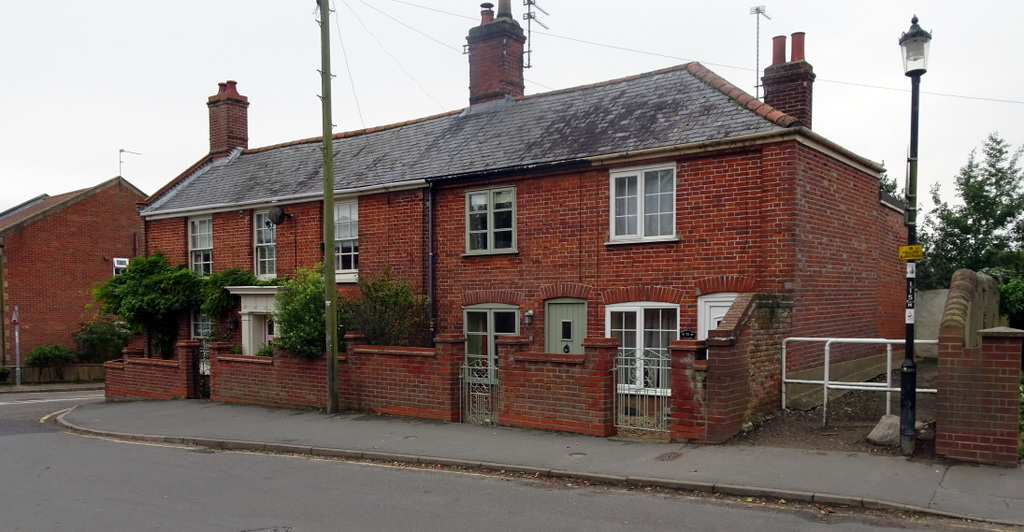
The present owners of 71 Black Street have an amazing collection of deeds for their property that they have been good enough to show me. They reveal a long history of the cottages that were once a row of four and are now three. Just like a house through time the deeds provide a glimpse into the lives of the people that lived there as well as the history of the buildings themselves.
Our story starts well before the present cottages were built although there were buildings there that pre-date the present homes. The deeds for what is now No71 start with documents dated 12th June 1800(1) and tell us that the properties that now face Black Street have always been linked with the land to their rear. Some of this land was freehold and other portions were held copyhold of the Manor of Martham for which there were no deeds because of the historic nature of ownership by the Lord of the Manor. Before 1800 John Groom(2) and his wife had held the land as copyhold(3) from the Manor and it had subsequently been transferred to William Coles and his wife Martha. On 12th June 1800 William & Martha Coles sold their lease interest in it to William Linford(4) for £120. These transactions were later confirmed and change of ownership agreed by the Lord of the Manor of Martham on 4th May 1801(5). The change of ownership can be seen reflected in the 1812 Martham Inclosure Award where William’s name appears on his plot that amounted to about two acres and four roods. The map is shown below.

William’s wife was Sarah, nee Frosdick, and they had three sons but by the time he died in May 1822 their only surviving son was Moses who had been born in Martham in 1777. William was buried in the graveyard at St Mary the Virgin. He does not seem to have made a will. Possibly because of the confusing mix of ownership between freehold and copyhold there was a delay in reporting the change of circumstances to the Martham Manor Court. It was eventually recorded in the Manorial Rolls on 2nd August 1824(5) and the record also tells us that there were already houses on part of the land that was named Church Gate. These houses predated those that are there now. The transfer of the land and buildings from father to son was agreed by the Lord of the Manor on 2nd August 1824. William’s wife Sarah died in June 1826 and like her husband she was buried at St Mary the Virgin in Martham but the exact position of their graves is unknown.
So, Moses had taken over occupation in 1822. He had married Martha Slegg at Great Yarmouth on 6th October 1805 and they went on to have four children. In his younger days he was a wheelwright but later became a carpenter and after 1822 he made good use of the land he had inherited from his father that had a 15ft thick seam of brick earth(8) that he used to become a brickmaker.
Moses and Martha were life-long Baptists and were staunch supporters of the new movement that had established its first church at Martham in 1800 on land adjacent to that owned by Moses and the same year he was ordained as a Deacon of the Baptist Church. Moses died on 16th November 1839 and Martha on 11th July 1866 and both are believed to be buried in the Baptist graveyard off what is now Oak Tree Close probably with other family members that are there but they don’t have a gravestone in their memory. At one time there were two memorial tablets mounted on the walls of the present Baptist Church which are shown here.
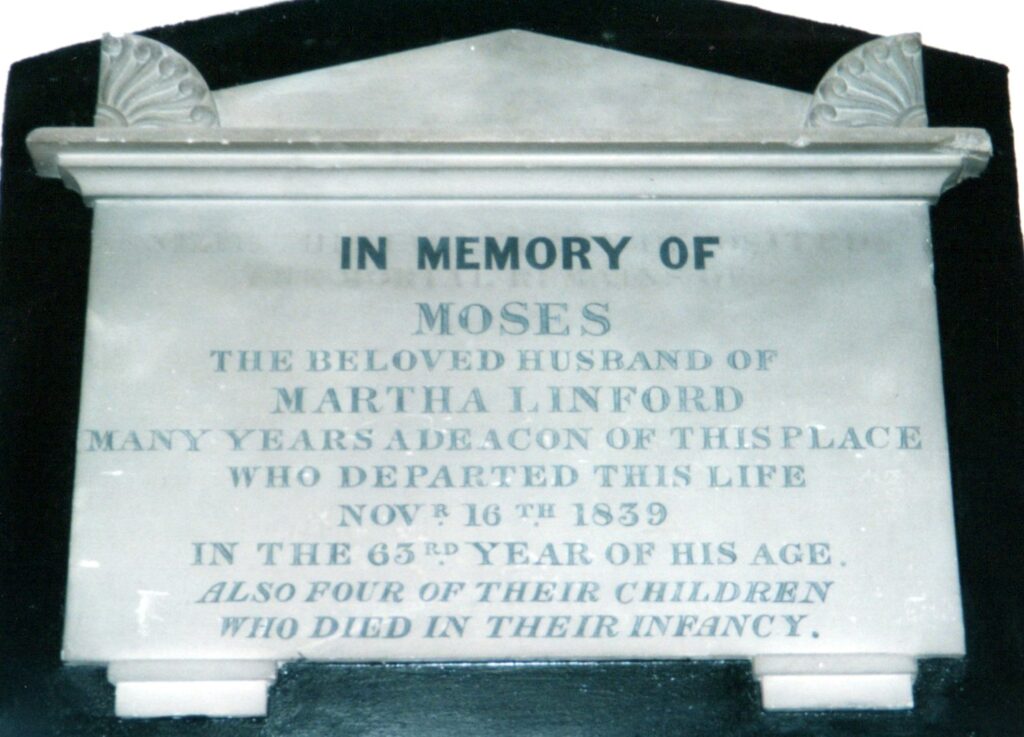

Moses made a Will dated 24th April 1835(6). It shows that he had been very successful, owning land and properties in both Martham and elsewhere. It was a complicated Will in which he left several properties and land in Martham to his sons without saying exactly where they were. He left a pightle and some land off Somerton Road to his son James: three tenements with yards, gardens and appurtenances to his son Robert: a house with a yard and garden together with arable land of about one acre and three roods to his son William and “messuages, lands hereditaments with appurtenances to his wife Martha for the natural term of her life”. He also left two personal legacies that were not to be paid until after the death of his wife. Finally, he also instructed his Executors to sell all the rest of his estate, lands, hereditaments and premises in Martham and elsewhere the income from which was to be equally split between his children. The houses and land associated with Church Gate were to be sold as part of this settlement to his children. His Executors(6) were his wife Martha, his son William and Robert Garnham(7) and they were charged with obtaining the best price possible for the houses and land.
I don’t know if this caused some discontent or disagreement within the family because James obviously wanted the property and a sale of the Church Gate land and properties took place on 31st October 1840(9) under which the Executors (basically his own family) sold him the land etc for £210 based on them being required to obtain the best price. The size of the plot identifies it as the same as that owned by his grandfather in 1812. The sale included some marshes down by the River Thurne that his grandfather had also owned. Again, it took two years but the sale and transfer of title was endorsed by the Lord of the Manor on 24th October 1842(10). The 1842 Martham Tithe Award nicely confirms and illustrates the same position. A copy of part of the map that goes with the Award is shown below. Plots 31 and 691 were owned by James. The east end of plot 691 would later have Church Gate Cottages built there, whilst plot 31 was the brickfield. Later, both would become Kirby’s Yard and then Oak Tree Close. The small plot No30 shows a building which was the original Baptist Church in Martham and was held in the name of the Baptist Church Trustees.
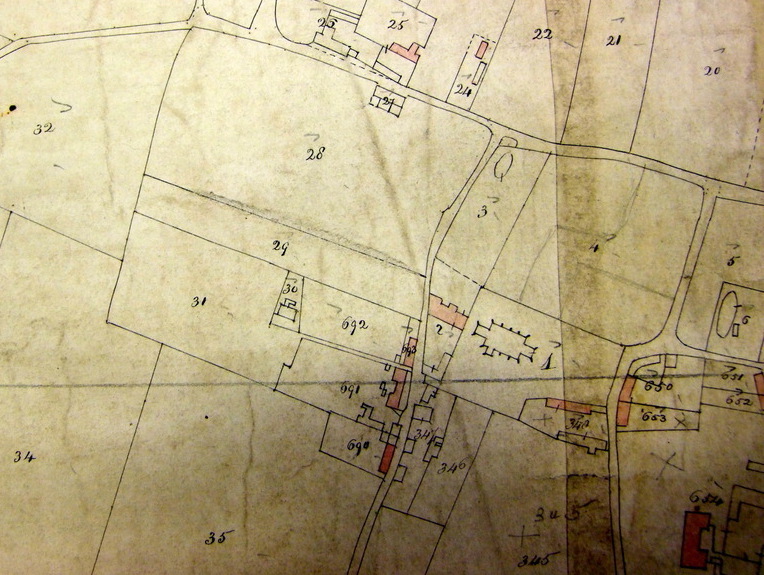
Five years passed and James must have become more successful and confident because at the age of 32 he borrowed £650(11) from Mrs. Matilda Womack(12) giving the Church Gate land as surety against default and the conditional surrender of his interests in the property in favour of Matilda, subject to him repaying the loan. The arrangement was acknowledged by the Lord of the Manor. This was the funding James needed to demolish the existing dwellings, barns and outhouses and build the current terrace of houses.
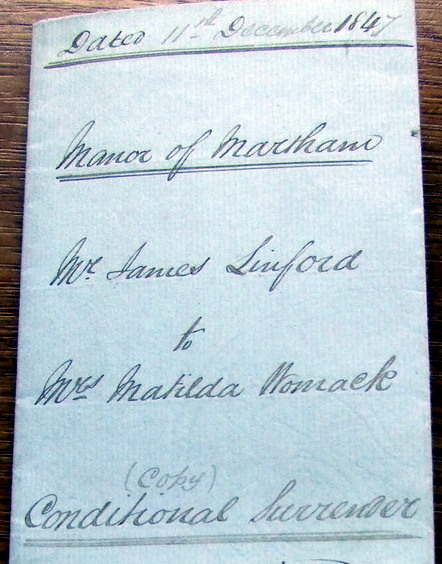
James then built the existing cottages between December 1847 and March 1851. We know this because the properties appear in the 1851 census and on 15th September 1852 an auction was held at the White Horse Inn, Great Yarmouth to sell the four new dwellings, that had sitting tenants, plus the adjoining brickyard and the marshes James had bought out of his father’s estate. On the right is a copy of the auction brochure published by Francis Clowes, Auctioneers.
The properties were sold in three lots described as follows:
Lot 1; newly erected brick and slate dwelling houses adjoining and standing in a commanding and pleasant situation near the Church. Each house has a garden, requisite out-buildings with an excellent supply of spring water attached. (The eastern end of plot No691 on the Tithe map).
Lot 2; A compact farm premises comprising a barn, stable, outbuildings, yard, brick ground and kiln, also a pightle together containing 2 acres, 2 roods & 13 perches of finest arable land adjoining lot 1. (Plot No31/691 on the Tithe map).
Lot 3; New broken and fast improving marsh land containing 4 acres, 0 roods & 12 perches situated near the windpump and the River Thurne. (Plots 486 & 487 on the Tithe map – not shown).
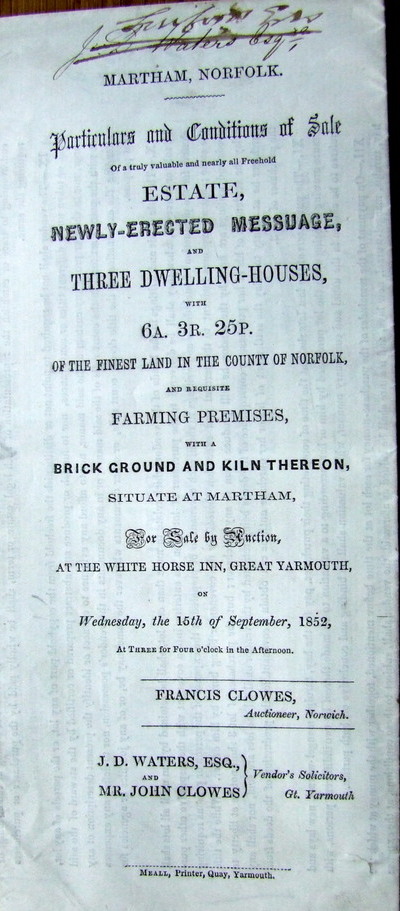
We can get some idea of the comparative size of the investment James made in building these dwellings by comparing the £650 loan he took out against the rental income stated in the auction details in 1852 in which it says they were let to Nicholas Woods for £33, 10s, 0d per annum. He in turn sub-let all four cottages.
We don’t know the outcome of the auction but the cottages may not have attracted a buyer because once again after a fairly long delay matters were reported to the Lord of the Manor. Mrs. Womack had died on 6th April 1852 and thereafter her affairs were managed by her Executors who were her daughter Matilda Knights Womack(13) and her son Arthur Lindoe Womack. On 22nd March 1854 they informed the Lord of the Manor that James Linford had repaid(14) the loan their mother had given him and the terms attached to the conditional surrender had been fulfilled. The copyhold reverted back to James Linford.
On 22nd March 1854 the close working relationship that James Linford had with the Womack family continued when he sold the houses at Church Gate to Matilda Knights Womack(13) and her brother Arthur for £200 which were on a plot of 3 rods and 7 perches. The purchase also included another piece of land from James measuring one acre, two roods and eight perches which was one of the marshes near the mill and boatyard at Cess formerly owned by William Linford that was plot No122 at the time of the 1812 Inclosure Award and renumbered 487 in the 1842 Tithe Award. The Lord of the Manor agreed the transfer of the copyhold on 14th June 1856.
The purchase did not include the land, yard and brickfield to the rear of the houses or the second marsh, plot No 486, which James retained.
Arthur Womack died on 26th August 1864 leaving his sister Matilda as the sole owner. She did not live at any of the cottages as they were just an investment and she let them out. She lived at Mettingham in Suffolk.
On 15th February 1871 an important transaction took place when Matilda bought out the copyhold from the Lord of the Manor of Martham for £112 to turn the properties into freehold(15).
On 16th March 1871 an unusual transaction took place when Miss Womack gave the cottages at Church Gate and her marsh at Cess to her nephew William John WOMACK. She conveyed to him the four cottages, barn, stable, outhouses, yards, gardens, orchard and a piece of arable land amounting to two acres, three roods and thirteen perches near the church and also her marsh at Cess as previously described. The conveyance read more like the wishes normally associated with a Will than a legal agreement as there was no payment or loan involved. Matilda died on 17th October 1873 so it appears that she was tidying up her estate before here death.
William John WOMACK kept the houses for the next eight years as part of his investments which he lived off whilst living at Mettingham, Suffolk. Throughout this period the four cottages were let to a variety of tenants. William died on 11th April 1879 and under the terms of his Will(16) the cottages and land were inherited and shared equally between his two sisters Anna Maria WOMACK (1837-1900) and Rosetta BEXFIELD, nee WOMACK (1845-1911).
Anna died on 26th October 1900 and left the whole of her estate to her sister Rosetta.
Rosetta died on 13th August 1911 and her estate was auctioned(17) by Messrs Spelman at The Star Hotel, Great Yarmouth on 4th October 1911. The advert for the auction is shown below.
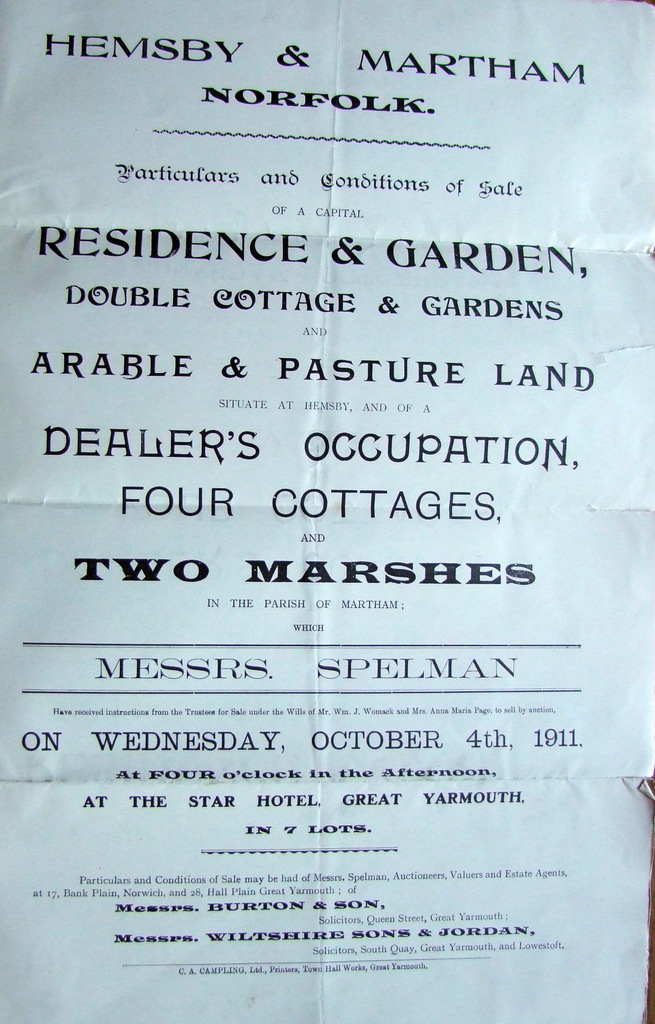
The auction(17) listed the properties as a piece of arable and accommodation land situated in Black Street near the Church together with a cart shed, stable, cow house, barn, cart lodge, chaff house and buildings erected there containing two acres, two roods and thirty perches or thereabouts as shown on the plan attached coloured yellow together with a right of access to a well and rights of way to the rear of adjoining houses. The houses were occupied by tenants who were George HAYTON (1852-1943); George GRIMES (1887-1976); Claude Gordan GRANT (1886-1960) and James Alfred YOUNGS (1858-1916). The houses were briefly described as follows:
Hayton’s (spelt Hayden in error) was a typical two-up-two-down cottage containing a sitting room, kitchen and two upstairs bedrooms. It is likely that this was No65 that was later demolished.
Grimes’s contained two sitting rooms, a kitchen and four bedrooms. It seems this was No67 as we know it.
And, those occupied by Grant and Youngs each had two downstairs rooms and one bedroom upstairs. These would have been Nos 69 & 71.
They had small front gardens and to the rear brick sheds and wash-houses. They shared outside toilets and a well.
Hayton and Grimes also rented an adjacent cart lodge.
The plan(18) below shows the area of the four cottages that were auctioned in red and the area of accommodation land with sheds and barns etc in yellow.
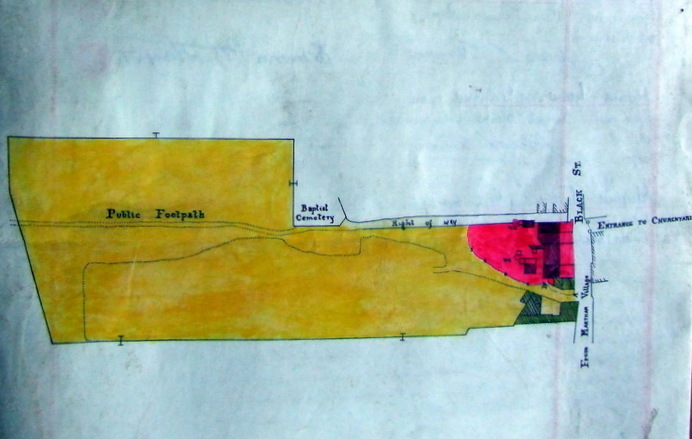
The auction could not have attracted too much interest and there must have been some negotiations after the sale because the sale of the four houses was split between two purchasers. The first was James Edwin Kirby (1863-1942) who was a brick and salvage merchant and had rented the yard before the auction. He lived across the road at Fairview House, Black Street and purchased the yard and Nos 69 and 71. The second was Miss Emma Margaret Hayton (1875-1960) who was the daughter of George Hayton the tenant of No65. Emma did not live there at the time of the auction but had grown up living at No65 & 67 with her parents and grandparents. She lived in London at the time of her purchase. At the conclusion of the purchase Emma signed an agreement for numbers 65 and 67 to share a well at the rear of the properties(19).
On 19th August 1920 Emma HAYTON sold 65 & 67 to James Edwin Kirby for £180. The properties were then called 2 & 4 Church Terrace, Black Street. They were described as two cottages with garden ground and appurtenances and were occupied by William James GREEN (1855-1921) and Claude Gordan GRANT (1886-1960) the son-in-law of James Edwin KIRBY.
James Edwin Kirby went on to run a very successful family business trading as timber merchants as well as providing farm services and road haulage etc from the yard to the rear of Church Gate Cottages which you can read more about by clicking HERE.
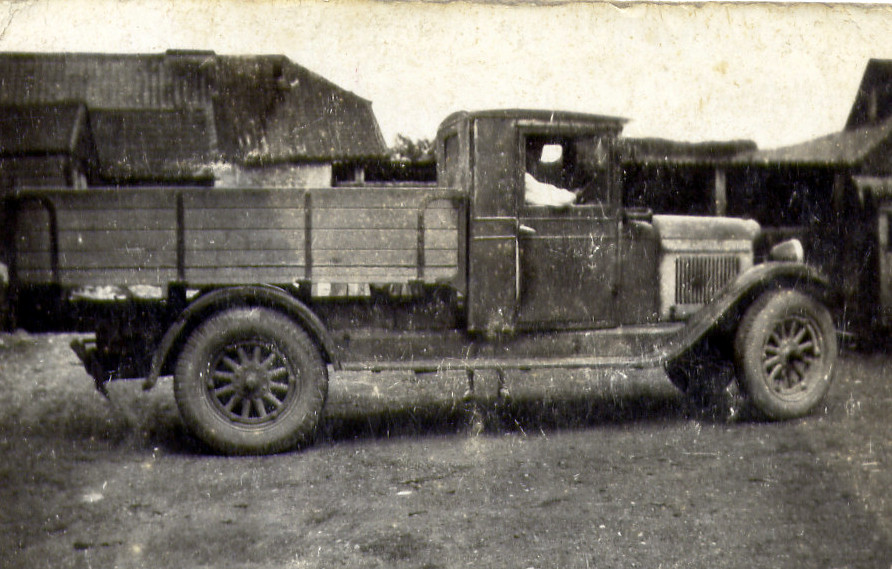
Occupiers
Despite the name Church Gate appearing in various deeds the cottages were never called that in census returns so it is difficult to trace the occupiers but using clues from the deeds and a certain amount of logic plus genealogy the following can be determined.
During the period 1800 to 1839 it is highly likely that William Linford and his son Moses actually lived there in houses that pre-dated the existing terrace. Moses son James Linford did not live at Church Gate Cottages. James and his brother had also purchased a grocers business in White Street belonging to Robert Garnham and James lived there with his mother in 1841 and 1851 and by 1861 he had moved to Great Ormesby.
The sale details from 1852 tell us about the occupiers of what was the four newly built cottages. They were:-
- Daniel Rust & his wife Charlotte, nee Pearce, with their baby daughter Ann. Daniel was a self employed millwright and carpenter. They were there for a short period around 1851/52 and had left by 1861.
- John Wright & his wife Elizabeth. John was an agricultural labourer and again they were there for only a short while around 1851/52 and had left by 1861.
- Benjamin Hodds & his wife Elizabeth, nee Easter. They lived there for many years from about 1851 to 1884 when Benjamin died and Elizabeth moved to Clark’s Farm where she lived with her niece Charlotte Watson.
- William Watson & his wife Ann, nee Lowne, lived there at the time of the 1851 & 1861 censuses but had moved to Surrey by 1871.
The deeds from 1912 give us more clues about occupiers as follows:
- George Hayton lived at No65 in 1911/12 and a more detailed look at his life shows that he was probably born at Church Gate Cottages when his parents William & Rebecca lived there. William was a gardener and coachman but was also better known for being the church sexton/parish clerk for many years until he died in 1892. His son George took over the same role as well as being an agricultural labourer. George Snr. was married three times and still lived there in 1939 when his wife was Lucy, nee Edwards. George died in 1943.
- Benjamin Grimes & his wife Anna, nee Culley, lived at No67 in 1911/12 along with their son George. Both father and son were bootmakers and they very soon moved out to their well-known shop in Repps Road.
- Claude Grant & his wife Ethel, nee Kirby, lived at No69 in 1911/12. Ethel was the daughter of James Edwin Kirby who owned the yard behind the cottages. Claude had worked on the railway and they later moved to Hall Road, Martham.
- James Youngs & his wife Lucy, nee Mason, lived there in 1911/12. He was a bricklayer. Lucy died in 1914 and James in 1916.
1939
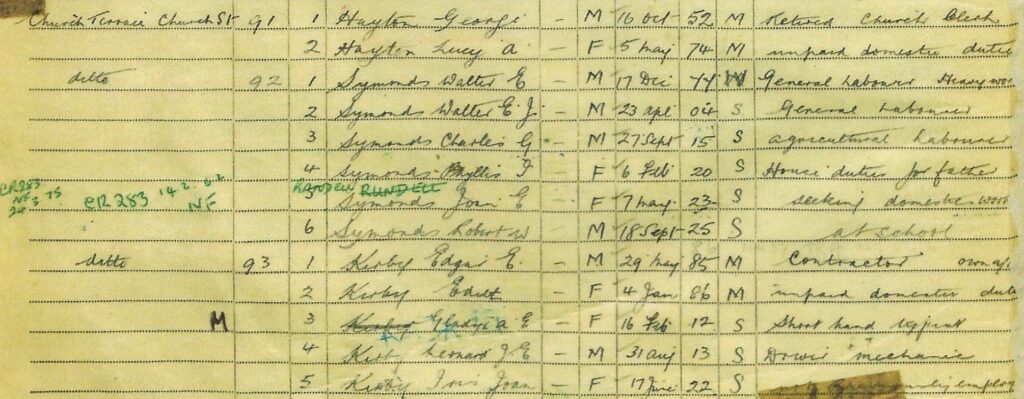
The 1939 Register gives us a better indication of who was living there at the time because for the first time it had its own distinct name which was Church Terrace rather than Church Gate. There were, however, only three households mentioned so the other house was either vacant or was being used as part of Kirby’s business. This part of the 1939 Register is shown on the left.
- As mentioned above George Hayton (1852-1943) lived there with his wife Lucy, nee Edwards.
- Edgar Kirby and his wife Edith lived there with four of their children, Edith, Gladys, Leonard and Iris. Edgar was the son of James Edwin Kirby who purchased all four cottages in 1911 & 1920.
- Walter Symonds (1877-1956), generally known by his second name of Edward, was a widower and lived there with his children Walter, Charles, Phyllis and Joan. Below is a lovely photo of Edward in Black Street standing at the south end of the terrace where Kirby’s had a couple of offices.

Note in the background the old church gates and the barns/stables that were once part of the Vicarage.
The shed/offices in the photo that were attached to No65 were demolished in the 1970’s when the access road to Kirby’s yard was widened.
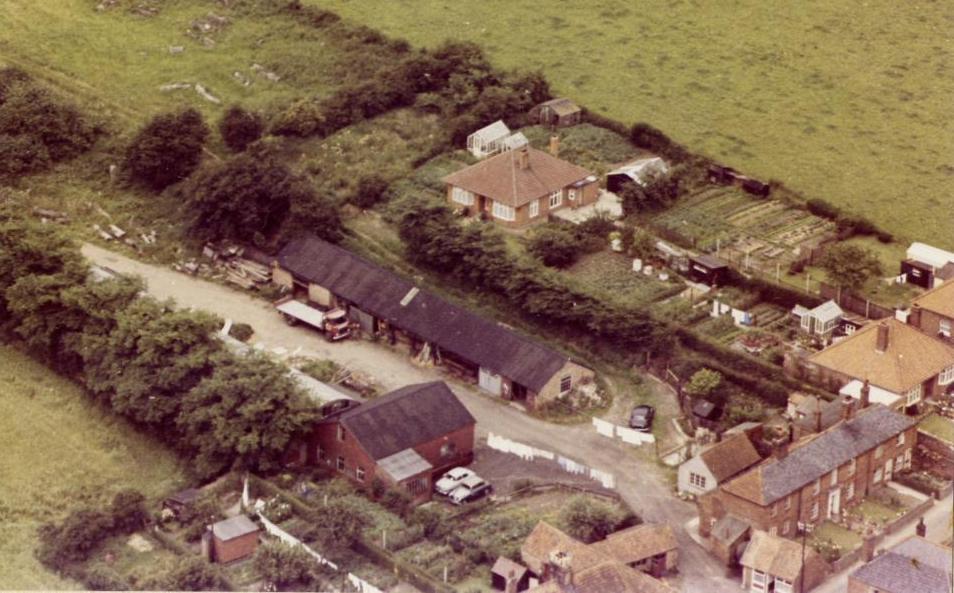
Back to Buildings Back to Places
Appendix & Sources
- Deeds, receipts, memorandum, signatures and seals in respect of 71 Black Street dated 12.6.1800.
- John Groom (1755-1817) was from Ormesby St Michael where he married the widow Ann BRUERTON on 7th August 1796.
- Copyhold was a form of land ownership common from the late middle ages. The name for this type of land tenure is derived from the act of giving a copy of the relevant title deed that is recorded in the Manorial Court according to the customs written down in the manorial roll. In return for being given land, a copyhold tenant was required to carry out specific manorial duties or services like helping gather in the harvest for the Lord of the Manor. The specific rights and duties of copyhold tenants varied greatly from one manor to another and many were established by custom. By the 19th century, many customary duties had been replaced with the payment of rent. Copyholds were gradually turned into ordinary holdings of land, either freehold or a 999 year lease, as a result of the Copyhold Acts during the 19th century.
- William Linford (about 1748 to 1822).
According to the claim made by William for the 1812 Martham Inclosure Award he owned plots Nos 122, 123, 241, 311, 312, 384, 391, 392 & 526 consisting of a total of 13 acres, 3 roods and 31 perches. Of these plots 311 & 312 were where Oak Tree Close is today and amounted to 2 acres and 4 roods. These plot numbers come from record CHC 11910 & BR 276/1/172 held in the Norfolk Record Office regarding the 1812 Estates belonging to the Dean & Chapter of Norwich because the official 1812 Inclosure Award map does not show the plot numbers although you can see William Linford’s name on the map. - Record of the General Court Baron of Martham held on 2nd August 1824 presided over by William Bell, steward, on behalf of Thomas Grove Esq. the Lord of the Manor.
- Moses Linford lived from 1777 to 1839.
In 1792 Moses was an apprentice wheelwright to William Woods of Martham. Later he became a carpenter and brickmaker. According to the 1822 deeds of 71 Black Street, Martham and 1824 records of the General Court Baron of Martham, Moses inherited all the copyhold land and property owned by his father William when he died in 1822. In 1835 Moses appeared in the Martham Poll Book as eligible to vote in West Flegg as a freeholder of house and land at Church Street (Black Street), Martham. In 1836 Moses appeared in White’s Directory as a brickmaker and was also in the West Flegg Register of Electors at Black Street. A copy of his will is at the Norfolk Record Office ref: PRDC 1/2/12 fol.79. MF478. His estate was probated on 21.3.1840 at Norwich. - Robert Garnham (1790-1863). Robert was born in Martham and was a very successful grocer and draper. When he was 32, he married his cousin Hannah GARNHAM. At one point they lived at Selwyn House on The Green. At the time of the 1842 Martham Tithe Award he also farmed 17 acres of land in and around the village. Later in life he became a seed merchant and an Agent for the Norwich Equitable Co.
- Brickearths are periglacial loess of wind-blown dust deposited under extremely cold, dry, peri- or postglacial conditions. The name arises from its early use in making house bricks its composition being suitable for brick-making without additional material being added and unlike clay the bricks can be hardened at lower temperatures.
- Lease, sale, indenture and conveyance dated 30th October 1840 for houses, barn, stable outhouses, yards, gardens orchard and piece of arable land amounting to about two acres, three roods and thirteen perches in respect of the same land owned by his grandfather, William, in 1812. The sale to James also included marsh land near the River Thurne.
- Acknowledgement by the Lord of the Manor to the change of ownership from Moses to James Linford dated 24th October 1842.
- 11.10.1847 and 11.12.1847. Conditional release of estate and indenture between James Linford and Matilda WOMACK for a loan of £650 based on security of property and land at Church Gate.
- Mrs Matilda WOMACK, nee Knights (1772-1852) was the wife of William WOMACK of East Somerton who was a successful farmer. He died on 30th January 1845 and they have a family monument in Winterton church.
- Miss Matilda Knights WOMACK (1800-1873). Daughter of William & Matilda WOMACK she lived with her widowed mother at The Green in 1851. She was an investor and never lived at Church Gate Cottages.
- 22.3.1854. Absolute surrender of title recorded by the Manor of Martham per the deeds of 71 Black Street, Martham.
- 15.2.1871. Indenture. Formal contract giving details of an agreement between The Lord of the Manor of Martham who by this time was John HEWITT and Miss Matilda Knights WOMACK whereby she paid £112 to convert the copyhold of the land. John HEWITT had become owner when he purchased the Lordship of the Manor from Thomas Fraser GROVE on 11.6.1870.
- Following the death of William John WOMACK on 11th April 1879 under which his sister Anna Maria WOMACK (1838-1900) and Frank BURTON were Executors.
William John WOMACK left his estate to be shared equally between his two sisters Anna Maria WOMACK and Rosetta Louisa BEXFIELD, nee WOMACK.
William John WOMACK died 11.4.1879 and his sisters inherited.
His sister Anna Maria PAGE, nee WOMACK died 26.10.1900 leaving her estate to her sister.
His sister Rosetta BEXFIELD, nee WOMACK died 30.8.1911 and her estate was auctioned at The Star Hotel, GY on 4.10.1911. - 4.10.1911 Sale Advert by Messrs Spelman. Cover page for sale of 7 lots including four cottages and two marshes. Lot 5 was the brick yard area. Lot 6 was the four adjoining cottages. The cottages were let to George HAYTON (1852-1943); George GRIMES (1887-1976); Claude Gordan GRANT (1886-1960) and James Alfred YOUNGS (1858-1916). Each house was described.
- 21.2.1912. Conveyance and Indenture with a site map. Between Frank BURTON, Solicitor of GY; William Womack PAGE (1843-1912) of Great Yarmouth and Womack BROOKS draper of Beccles being the Trustees of William John Womack deceased, the vendors, and Mr James Edwin KIRBY (1863-1942) of Martham and Emma Margaret HAYTON (1875-1960) spinster, the purchasers concerning the whole of the yard etc and four houses at Black Street.
- Agreement 21.2.1912. Use of well by adjoining properties at 65 & 67 Black Street. Authority from Miss Emma Margaret HAYTON.
- 19.8.1920. Indenture and Conveyance. Miss Emma Margaret HAYTON, spinster of 4 Church Terrace (No67) the vendor to James Edwin KIRBY, the purchaser, for £180. Property described as two cottages (65 & 67) with garden ground and appurtenances thereto belonging situated in Black Street, Martham occupied by William James GREEN (1855-1921) and Claude Gordan GRANT (1886-1960) son-in-law of James Edwin KIRBY.